Useful tools for identifying and risk assessing hand-intensive work

Hand and forearm injuries are common in hand-intensive work. To prevent injuries, risk assessments of hand-intensive work should be carried out. The project has three aims: 1) To develop and validate a form that can be used to investigate whether risk assessment of hand-intensive work needs to be carried out in workplaces. 2) To translate, adapt and validate an effort rating scale, so that it is suitable for estimating hand effort at work. 3) To develop a way to process electrical signals from muscle activity in the forearm, so that these signals can be used as input in the validated risk assessment method the Distal Upper extremity tool.
Details
- Funder: AFA Insurance
Project description
According to Swedish Work Environment Act and AFS:2012:2, employers must investigate whether employees perform work that may be hazardous to health or unnecessarily tiring due to hand-intensive work. This work is often done in consultation with the occupational health service. Previous studies have shown that there is uncertainty among both employers and occupational health services about how to identify hand-intensive work. In addition, there are no Swedish methods suitable for risk assessment of hand loads when the work consists of several different steps. The Distal Upper Extremity Tool is a validated risk assessment method based on the fact that the risk of injury to the forearm and hand can be evaluated based on the estimated total load during an entire working day. The method has not been translated into Swedish and the subjective assessment scale (OMNI-RES scale) used in the method is not specifically adapted to measure the load on the forearm and hand. In this project, we will translate and develop an adapted version of the OMNI-RES scale. The new scale will be evaluated by comparing workers' estimates of estimated force exertion with the new scale with objectively measured force exertion during grasping work.
Another possible approach to improving the quality of risk assessments and obtaining more objective measures of exposure levels is to use technical methods to measure hand strength and repetitiveness instead of subjectively estimating effort. Muscle activity in the forearm can be measured by surface electromyography (EMG). In this project, we will test whether it is possible to use these signals, as an alternative to subjective estimation and visual observations, in risk assessment of hand-intensive work.
The project responds to a need expressed by workplaces and occupational health services to simplify, clarify, and increase the quality of the methodology for examination and risk assessment of hand-intensive work.
Co-operating partners
The project is carried out in collaboration with Occupational and Environmental Medicine in Lund.
